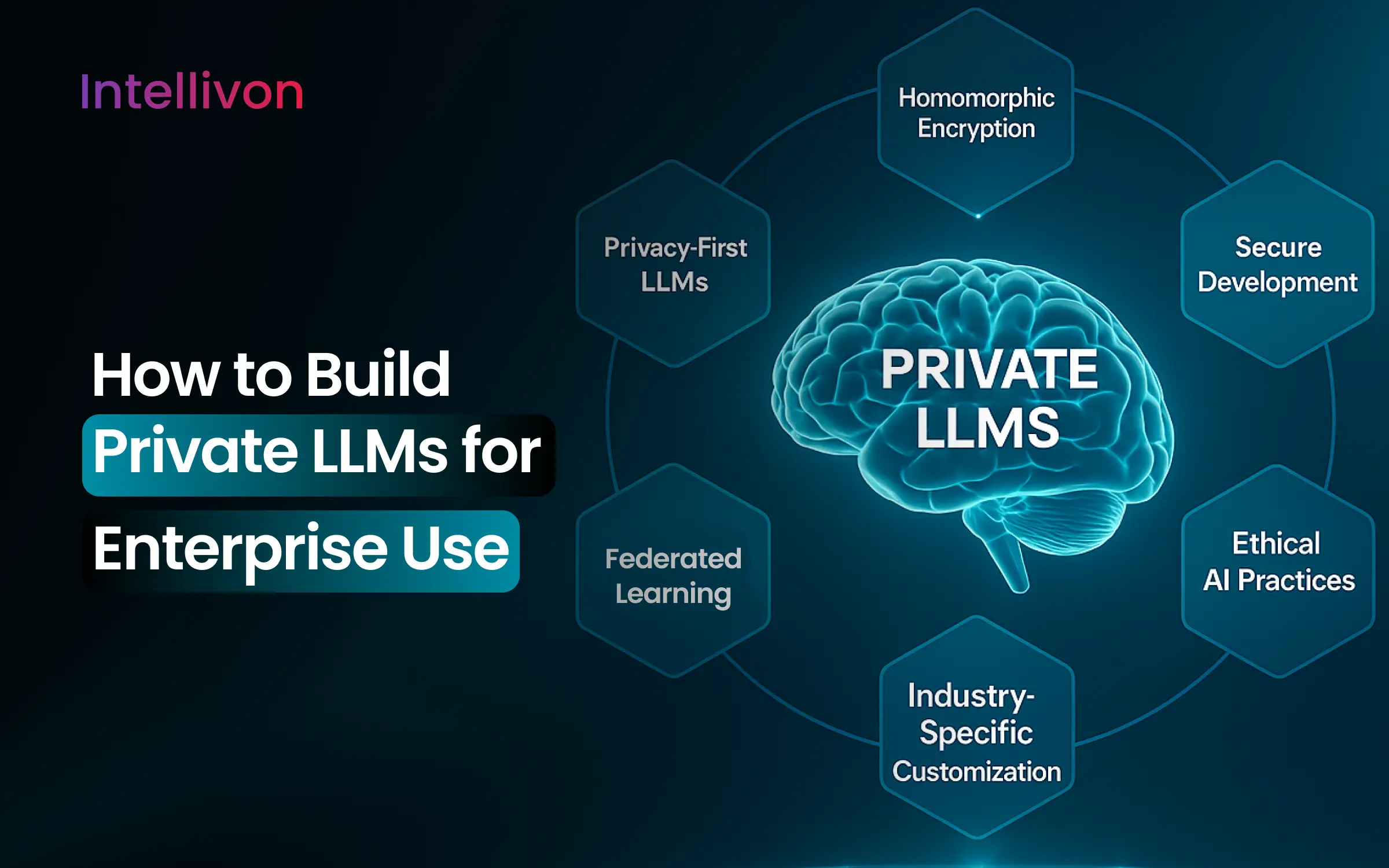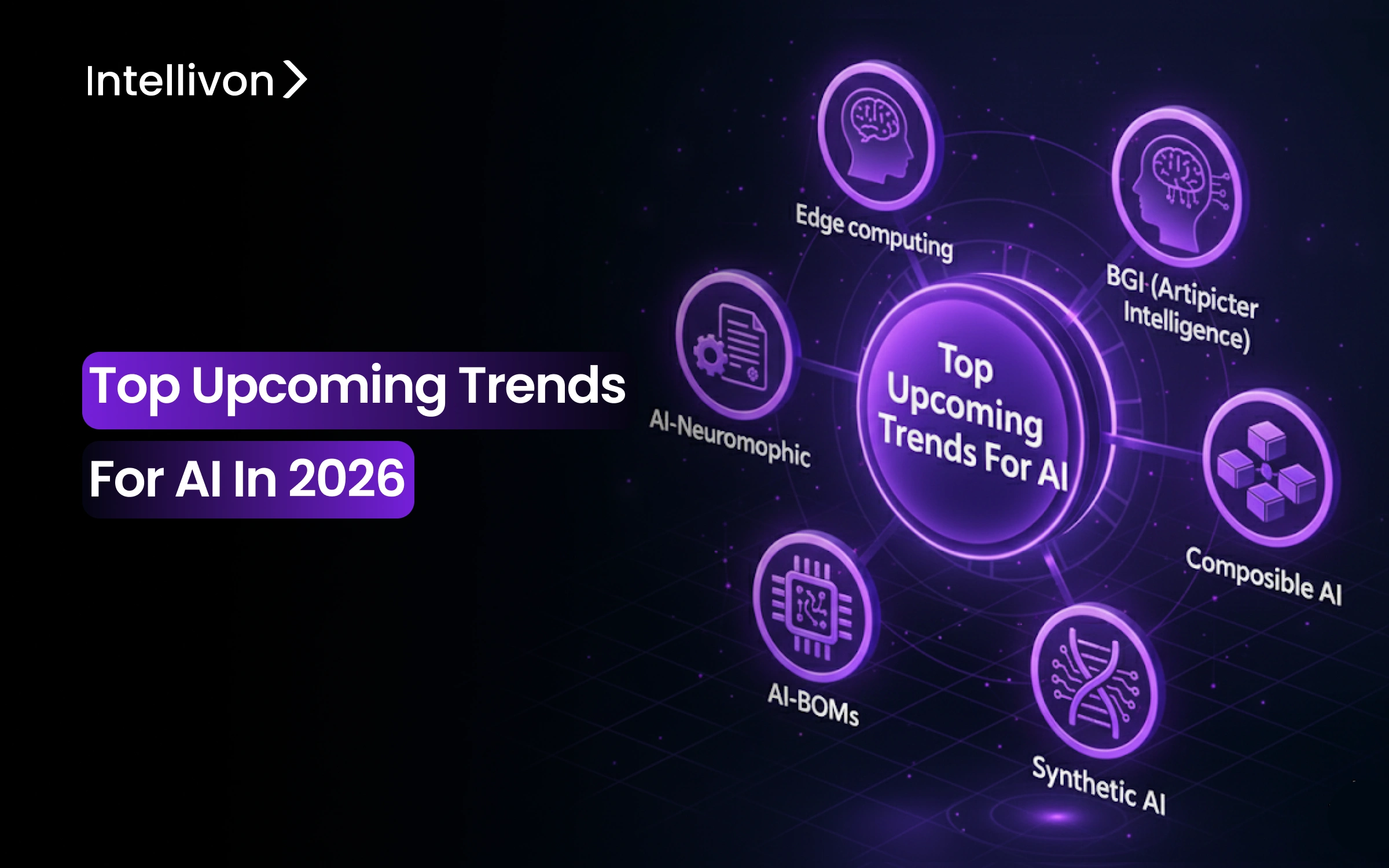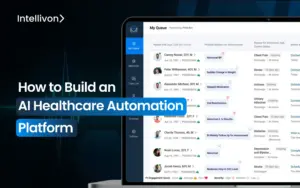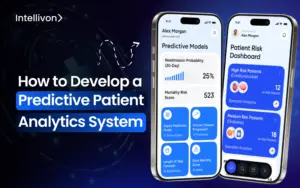The world of artificial intelligence is changing quickly. As we look ahead, the AI trends for 2026 will significantly alter how enterprises work, innovate, and compete. We are on the brink of a time when AI has transcended the role of a tool for efficiency and has become the main force that separates market leaders from followers. Organizations that understand and prepare for these new trends today will be the ones creating tomorrow’s success stories.
What makes 2026 exciting is not just the technological advancements we see but the evolution of AI from optional additions to essential infrastructure. Companies no longer ask whether they should use AI, but rather how quickly they can reshape their entire operations around intelligent systems. This change is a complete rethink of what can happen when human skill meets artificial intelligence.
At Intellivon, we have been leading this change by helping innovative companies navigate the challenges of AI integration while preparing them for future opportunities. As we look at the key trends that will shape 2026, you will learn not only what to expect but also how we help enterprises adopt these trends to adapt to a stronger, more flexible, and more competitive future.
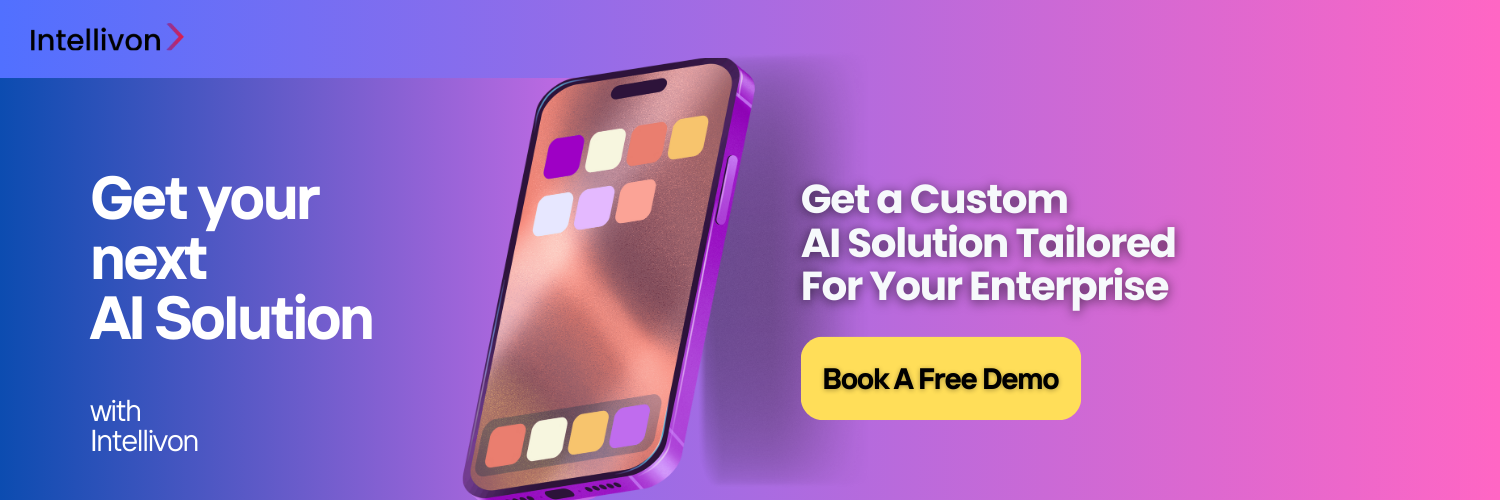
Key Market Takeaways for AI in Enterprise Operations
The enterprise AI market is projected to increase from USD 97.2 billion in 2025 to USD 229.3 billion by 2030. This represents an annual growth rate of 18.9%, according to a report from Mordor Intelligence. The main drivers of this growth are the quick adoption of generative AI, systems that automate complex tasks, and a rising need for specialized silicon to shorten inference times.
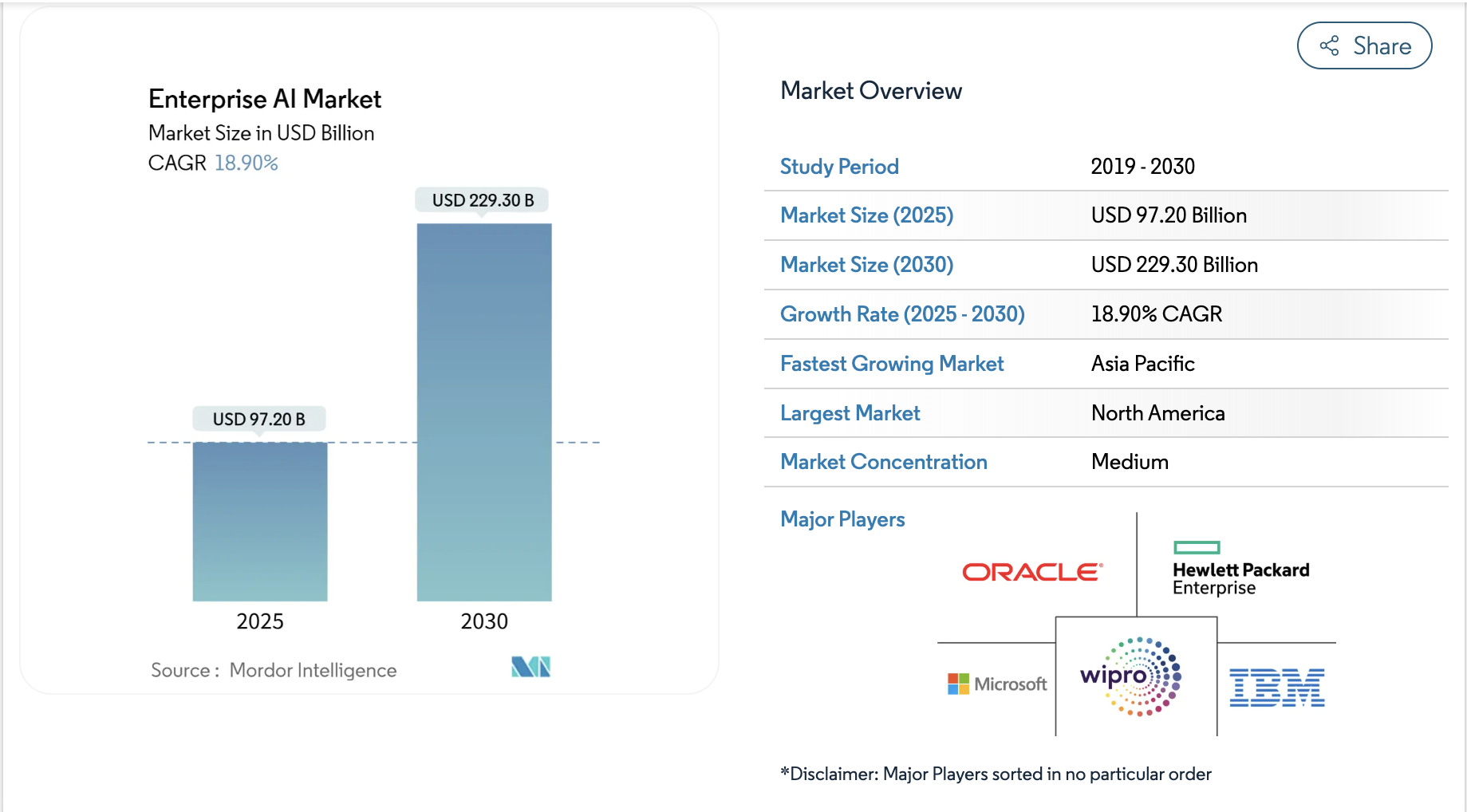
- The growing need for automation, AI-driven solutions, and the ability to process large enterprise data are major factors fueling this growth.
- Specialized hardware for AI, such as GPUs and TPUs, is also seeing rapid growth, with demand for AI chips expected to grow at over 23% annually.
- Hybrid and edge AI models are outpacing traditional public cloud deployments, as businesses prioritize lower latency and data sovereignty.
- Healthcare is leading AI investment, with a projected annual growth rate of 22.17%.
- AI is predicted to significantly boost global economic growth, with some estimates suggesting it could add more than $15 trillion in revenue by 2030 across various sectors.
Trend 1. Model Supply-Chain Governance (AI-BOMs, Passports)
AI is no longer a black box. As enterprises deploy hundreds of models, the question arises: What’s really inside our AI? Model supply-chain governance provides the answer through AI Bills of Materials (AI-BOMs) or “AI passports.” These detailed inventories record training data, dependencies, and risks, ensuring compliance, security, and transparency. With regulations like the EU AI Act tightening, this is quickly moving from best practice to mandatory.
Why It Matters for Enterprises
AI-BOMs reduce hidden risks and compliance issues. They help enterprises detect bias, track intellectual property, and avoid security vulnerabilities before deployment. This transparency builds regulator and customer trust, making it easier to scale AI responsibly.
Enterprise Adoption Process
Organizations start by creating an AI model inventory using automated discovery tools. Each model then gets an AI-BOM documenting training data, dependencies, and known issues. Enterprises integrate this into CI/CD pipelines, ensuring new models generate AI-BOMs automatically. High-risk models undergo compliance and ethics reviews, while continuous monitoring detects data drift or new vulnerabilities in production.
Real-World Example: JPMorgan Chase

JPMorgan Chase has invested heavily in AI model governance to comply with strict financial regulations. The bank created a centralized system that inventories every AI model in use, from fraud detection to credit scoring.
Each model is paired with detailed documentation, like its training data, assumptions, and dependencies, essentially an AI-BOM. This approach not only streamlines compliance audits but also reduces the risks of bias or unauthorized models influencing critical financial decisions.
By adopting AI supply-chain governance early, JPMorgan has positioned itself as a leader in responsible AI deployment within the banking sector.
Industry Use Cases
1. Healthcare Model Validation
Hospitals rely on AI-BOMs to prove diagnostic tools weren’t trained on biased or incomplete datasets. This reduces the risk of patient harm and ensures compliance with health regulators. By tracing model lineage, healthcare providers can confidently integrate AI into clinical workflows without risking safety.
2. Financial Compliance Audits
Banks and insurers use AI-BOMs to meet strict model risk management regulations. Documenting model assumptions, training data, and dependencies makes audits faster and less resource-heavy. This also provides executives with confidence that models driving lending or fraud detection decisions are transparent and defensible.
3. Automotive Safety Systems
Car manufacturers deploy AI-BOMs to track every component in autonomous driving software. This traceability ensures that if a system fault occurs, they can immediately identify problematic datasets or libraries. It also strengthens compliance with road safety authorities, where accountability is essential to gaining public trust.
Trend 2: Multi-Agent AI Systems
Multi-agent AI systems are redefining how enterprises approach complex workflows. Instead of relying on a single model, companies are building teams of AI agents that collaborate, validate, and delegate tasks. Each agent specializes in an area, such as research, compliance, and communication, and works with others to complete sophisticated processes. By 2026, this trend will shift from pilot programs to full enterprise integration.
Why It Matters for Enterprises
Most enterprises face limits when using isolated AI models. One model may be great at summarization, another at compliance checks, and another at customer interactions, but individually, they cannot handle multi-step, high-stakes workflows. Multi-agent AI solves this by combining different strengths, improving accuracy, and reducing risks. The result: enterprises can automate processes that once required large teams of specialists, cutting costs while speeding up results.
Enterprise Adoption Process
Adoption starts with identifying workflows where multiple checks are essential, such as legal reviews, research automation, or regulatory compliance. Enterprises then deploy frameworks like LangChain, AutoGen, or CrewAI to coordinate agent collaboration. Governance rules are added so one agent generates results, while others fact-check or enforce compliance. Over time, these systems are integrated into CRMs, ERPs, and CI/CD pipelines, creating AI “departments” that work alongside human teams.
Real-World Example: Siemens
Siemens has piloted multi-agent AI systems in its engineering and manufacturing divisions. Instead of relying on a single AI model, they deploy agents that collaborate: one generates design options, another tests them against safety standards, and a third optimizes for energy efficiency. This multi-agent workflow has reduced product design cycles, ensured compliance with EU regulations, and accelerated innovation in areas like smart infrastructure and mobility.
Use Cases
1. Legal Contract Analysis
Enterprises deploy multiple AI agents to manage contracts at scale. One extracts key clauses, another checks for compliance across jurisdictions, and a third highlights risks. This approach reduces manual workload for legal teams, speeds up negotiations, and ensures regulatory consistency in global operations.
2. Pharmaceutical Research Automation
Drug development companies use multi-agent systems to scan vast research libraries, model molecular interactions, and validate findings against safety requirements. This reduces R&D timelines, improves accuracy in clinical predictions, and helps bring therapies to market faster while keeping compliance intact.
3. Customer Support Orchestration
Enterprises enhance customer experience by coordinating agents: one manages queries, another retrieves customer history, and a third resolves issues or escalates when needed. This creates personalized, efficient support that lowers call center costs and improves customer satisfaction scores.
Trend 3: Synthetic Data at Scale
As enterprises adopt AI at speed, many face the same barrier: a lack of quality training data. In regulated industries, data access is limited by privacy concerns, while in new domains, data simply doesn’t exist yet.
Synthetic data solves both problems by generating realistic, artificial datasets that mimic real-world patterns without exposing sensitive information.
Why It Matters for Enterprises
Without quality data, even the most advanced AI models underperform. Synthetic data helps enterprises overcome data scarcity, regulatory restrictions, and bias issues. It enables faster training, broader scenario coverage, and stronger privacy protections. For enterprises in highly regulated sectors, it creates a way to innovate with AI while staying compliant with GDPR, HIPAA, and other data protection laws.
Enterprise Adoption Process
Adoption usually begins with identifying data gaps, areas where real-world data is incomplete, sensitive, or costly to obtain. Enterprises then deploy synthetic data generation tools to build datasets that preserve statistical accuracy while stripping out personal identifiers. Many companies integrate synthetic data pipelines into ML workflows, using them alongside real data for training. Finally, enterprises implement validation frameworks to ensure synthetic datasets maintain fidelity and fairness before feeding them into production models.
Real-World Example: BMW Group
BMW Group uses synthetic data to train its autonomous driving systems. Real-world driving data is often incomplete, with rare but critical edge cases (like extreme weather or unexpected pedestrian behavior) hard to capture. By generating synthetic driving scenarios, BMW can safely test and train AI models at scale, ensuring vehicles respond effectively to diverse, high-risk situations. This has accelerated development timelines and reduced reliance on costly road-testing.
Use Cases
1. Healthcare Model Training
Hospitals and research institutions use synthetic patient data to train AI diagnostic systems. This ensures models can identify rare diseases without exposing sensitive medical records. By generating diverse patient profiles, healthcare providers improve model accuracy and inclusivity, making AI safer for deployment in clinical settings.
2. Financial Fraud Detection
Banks use synthetic transaction data to test fraud detection systems. Real fraudulent patterns are rare and difficult to capture at scale. With synthetic data, enterprises can simulate millions of fraud scenarios, strengthening model performance while avoiding exposure of customer financial records.
3. Autonomous Vehicle Testing
Automakers generate synthetic driving data to cover rare but vital edge cases like near-miss accidents, snowy roads, or unusual traffic events. This enables continuous training of autonomous driving AI, reducing accidents and improving safety without waiting for rare events to occur in the real world.
Trend 4: AI-Powered Sustainability Intelligence
Enterprises are under growing pressure to meet ESG (Environmental, Social, and Governance) targets while maintaining profitability. AI-powered sustainability intelligence is emerging as the solution. By collecting and analyzing real-time data across energy usage, emissions, and supply chains, AI enables enterprises to measure, track, and reduce their environmental footprint. With climate regulations tightening in the EU, U.S., and Australia, sustainability-focused AI is moving from optional to essential.
Why It Matters for Enterprises
Sustainability has become a competitive differentiator. Enterprises that can prove carbon-neutral operations or sustainable supply chains win favor with regulators, investors, and eco-conscious customers. AI-powered sustainability intelligence provides the visibility and predictive power needed to achieve these goals while reducing costs.
Enterprise Adoption Process
Adoption starts with data collection from sensors, IoT devices, and supply chain systems. AI models then process this data to detect inefficiencies, predict emissions trends, and recommend optimizations. Enterprises integrate sustainability dashboards into their ERP and reporting systems to track progress against ESG goals. Over time, predictive AI models automate decision-making, like adjusting energy consumption in real time or sourcing from greener suppliers.
Real-World Example: Unilever
Unilever has embedded AI-driven sustainability tools across its global operations. Using AI, the company monitors energy consumption in factories, optimizes transportation routes to cut fuel use, and analyzes supplier data to ensure sustainability compliance. This approach has allowed Unilever to move closer to its net-zero carbon goals while lowering operational costs.
Use Cases
1. Carbon Footprint Analysis
Manufacturers use AI to analyze emissions across plants, logistics, and suppliers. AI identifies hotspots for energy waste, enabling targeted interventions. This empowers companies to not only meet regulatory requirements but also reduce operational costs significantly.
2. Sustainable Supply Chain Management
Retailers and logistics providers use AI to evaluate suppliers against sustainability metrics. By predicting risks in sourcing and transportation, enterprises ensure compliance with ESG standards and avoid penalties, while also improving brand reputation.
3. Energy Optimization in Real Time
Enterprises with large facilities, such as data centers or factories, deploy AI to dynamically optimize energy usage. Systems can reduce consumption during peak demand hours, cutting costs and lowering emissions simultaneously.
Trend 5: Domain-Specific Large Language Models (LLMs)
While general-purpose LLMs dominate headlines, enterprises are moving toward domain-specific models tailored for their industries. These models are fine-tuned on specialized data, like medical records, legal contracts, or financial documents, delivering more accurate and relevant outputs. By 2026, domain-specific LLMs will be central to enterprise adoption strategies.
Why It Matters for Enterprises
Generic LLMs can produce errors or irrelevant responses when applied to high-stakes industries. Domain-specific LLMs reduce these risks by leveraging specialized training datasets. This not only improves accuracy but also enhances trust among regulators, employees, and customers in sensitive fields like healthcare and finance.
Enterprise Adoption Process
Enterprises typically begin by fine-tuning open-source or commercial LLMs with domain-specific data. Models are then validated against compliance standards, ensuring outputs are reliable and safe. Over time, enterprises deploy these models in customer-facing systems, compliance tools, and knowledge management workflows, integrating them with existing platforms like CRMs and ERPs.
Real-World Example: Mayo Clinic
Mayo Clinic is piloting domain-specific LLMs trained on anonymized patient records and clinical guidelines. These models assist physicians by generating draft reports, surfacing treatment recommendations, and analyzing patient histories. The result: reduced administrative burden for doctors and more consistent, accurate patient care.
Use Cases
1. Financial Document Analysis
Banks deploy domain-specific LLMs trained on regulatory filings, risk models, and compliance manuals. This enables faster document reviews, reduces compliance costs, and ensures consistent adherence to financial regulations across regions.
2. Clinical Decision Support
Hospitals use medical-specific LLMs to assist doctors with treatment planning. The models provide evidence-based recommendations, improving care quality while reducing diagnostic errors in complex cases.
3. Retail Personalization
Retailers fine-tune LLMs on product catalogs and customer data. These models generate highly tailored product descriptions, recommendations, and campaigns that align with both brand voice and customer preferences, increasing conversion rates.
Trend 6: Autonomous AI Security Defenses
With cyber threats escalating, enterprises are adopting AI not just for detection but for autonomous defense. These systems continuously scan digital environments, predict threats, and neutralize attacks in real time without human intervention. By 2026, autonomous AI security will be a cornerstone of enterprise resilience.
Why It Matters for Enterprises
Traditional security tools react after an incident occurs, often too late. Autonomous AI flips this by predicting and preventing attacks. Enterprises that embrace this trend reduce downtime, avoid costly breaches, and comply with increasingly strict cybersecurity regulations across regions.
Enterprise Adoption Process
Adoption begins with deploying AI-powered monitoring tools that analyze network traffic and user behavior. Enterprises then integrate machine learning models that predict vulnerabilities before attackers exploit them. Over time, autonomous AI systems are given authority to take corrective action, such as isolating infected systems or blocking suspicious transactions, without waiting for human approval.
Real-World Example: Commonwealth Bank of Australia
Commonwealth Bank has implemented AI-driven cybersecurity defenses that monitor billions of transactions daily. The system proactively identifies unusual patterns, predicts fraud attempts, and stops them before customers are affected. This autonomous approach has dramatically reduced fraud losses and improved customer trust.
Use Cases
1. Proactive Threat Detection
Enterprises deploy AI systems to scan for anomalies across networks and devices. These models identify potential intrusions before they occur, reducing the likelihood of successful cyberattacks.2. Fraud Prevention in Banking
Banks use autonomous AI to monitor real-time financial transactions. Suspicious activities are flagged and blocked instantly, minimizing losses and ensuring compliance with anti-money laundering regulations.
3. Ransomware Defense
AI systems detect and isolate ransomware before it spreads. By acting instantly, they prevent downtime, protect sensitive data, and avoid multimillion-dollar ransom payments common in enterprise-scale attacks.
Trend 7: AI + Quantum Hybrid Computing
Quantum computing is still in its early stages, but enterprises are already experimenting with combining it with AI. Hybrid approaches allow quantum computers to tackle complex optimization problems while AI models manage data interpretation and real-world applications. By 2026, early adopters will gain advantages in industries like finance, logistics, and pharmaceuticals.
Why It Matters for Enterprises
Traditional computing struggles with problems involving massive variables, like global logistics or portfolio optimization. AI-quantum hybrids can handle these with greater efficiency, providing competitive advantages in cost savings and decision-making. For enterprises, being “quantum-ready” ensures they stay ahead of rivals when this technology scales.
Enterprise Adoption Process
Adoption begins with pilots in optimization-heavy areas, often run in partnership with quantum providers like IBM, D-Wave, or Google. Enterprises train AI models to generate inputs for quantum systems, then interpret outputs for business decisions. Integration with existing workflows allows Quantum to solve niche problems while AI translates results into actionable insights.
Real-World Example: Volkswagen
Volkswagen has tested AI-quantum systems to optimize traffic flow in urban environments. Quantum algorithms model countless variables like traffic lights, congestion, and driver behavior, while AI translates results into actionable adjustments. This hybrid system aims to reduce gridlock and emissions in major European cities.
Use Cases
1. Portfolio Optimization in Finance
Banks and investment firms use quantum-AI systems to simulate millions of portfolio combinations instantly. AI interprets results, helping advisors balance risk and return more effectively than traditional methods.
2. Pharmaceutical Molecule Discovery
Drug companies apply AI to model molecules and quantum computing to simulate interactions. This combination reduces the time and cost of discovering new medicines while improving safety outcomes.
3. Global Logistics Optimization
Supply chain enterprises use quantum to model transport networks under different conditions, with AI analyzing results to recommend routes that reduce costs and carbon emissions.
Trend 8: Generative AI in Core Enterprise Apps
Generative AI is being embedded directly into enterprise software systems like ERP, CRM, and productivity tools. Instead of operating as stand-alone platforms, AI becomes a native feature of daily business operations. By 2026, this integration will be widespread across industries.
Why It Matters for Enterprises
Embedding generative AI directly into core apps allows employees to work faster and smarter without leaving familiar platforms. From automated reporting to contract drafting, AI augments existing workflows, boosting productivity and decision-making accuracy.
Enterprise Adoption Process
Adoption starts with upgrading enterprise software to AI-enabled versions offered by vendors like Microsoft, Salesforce, and SAP. Enterprises then integrate generative AI with their own datasets, using retrieval-augmented generation (RAG) to ground outputs in business-specific knowledge. Rollouts often start with low-risk functions like automated documentation before expanding into decision-critical processes.
Real-World Example: Microsoft + PwC

PwC has rolled out Microsoft 365 Copilot across global teams. Employees use generative AI to summarize emails, draft reports, and create presentations. tasks that previously consumed hours. Early pilots showed significant productivity gains and higher employee satisfaction.
Use Cases
1. Automated Business Reporting
Generative AI creates customized financial or operational reports using live ERP data. This reduces reliance on analysts for routine reporting and improves decision-making speed.
2. Smart Documentation for Legal Teams
Legal departments use generative AI embedded in document management systems to draft contracts, highlight risks, and summarize clauses. This reduces review times while ensuring compliance with legal standards.
3. Customer Insights in CRM
CRM platforms enhanced with generative AI summarize customer history and suggest personalized next actions, helping sales teams close deals faster and improve customer retention.
Trend 9: AI for Workforce Intelligence & Skills Matching
Enterprises are facing a talent crisis, with skill gaps widening across industries. AI-powered workforce intelligence tools are emerging to match employees with roles, identify training opportunities, and support reskilling programs. By 2026, skills intelligence will become a standard component of enterprise HR systems.
Why It Matters for Enterprises
Enterprises that fail to address skill gaps risk losing competitiveness. AI-based skills intelligence ensures employees are matched to the right roles, reduces turnover, and supports long-term growth. For employees, it creates clearer career paths and opportunities for advancement.
Enterprise Adoption Process
Adoption typically starts with integrating AI-driven skills platforms into HR systems. These tools analyze employee profiles, learning records, and performance data to create skills maps. Enterprises then use this data to match employees to projects, recommend personalized training, and forecast workforce needs. Over time, AI becomes central to strategic workforce planning.
Real-World Example: Unilever
Unilever has adopted AI-powered skills mapping tools across its workforce. The system identifies skill gaps, suggests personalized learning modules, and matches employees to future roles. This has improved retention rates and helped Unilever stay competitive in talent management.
Use Cases
1. Reskilling Program
Enterprises use AI to recommend training paths for employees whose roles are becoming obsolete. This supports smoother transitions and reduces layoffs, while ensuring the business retains valuable institutional knowledge.
2. Talent Optimization
AI maps employees’ skills against enterprise needs, ensuring workers are deployed on projects where they’ll have the greatest impact. This reduces inefficiencies and improves employee engagement.
3. Strategic Workforce Planning
Enterprises use AI forecasting to anticipate future skill shortages. HR leaders can then proactively design recruitment and training strategies, ensuring the workforce evolves with business goals.
Trend 10: Edge AI for Real-Time Operations
Edge AI pushes intelligence closer to where data is generated—factories, hospitals, warehouses, and vehicles. Instead of sending data to the cloud, processing happens locally, enabling real-time insights and decisions. By 2026, edge AI adoption will accelerate in industries where speed and reliability are critical.
Why It Matters for Enterprises
Cloud processing introduces latency, which is unacceptable in scenarios like healthcare monitoring or industrial safety. Edge AI provides instant responses while reducing bandwidth costs and improving data privacy. For enterprises, this means safer operations, faster decisions, and reduced dependence on centralized cloud infrastructure.
Enterprise Adoption Process
Adoption often begins with IoT-enabled operations, where enterprises deploy AI models on edge devices like sensors or cameras. These models analyze data in real time and trigger automated actions. Over time, businesses expand edge AI across entire facilities or fleets, integrating results back into central systems for monitoring and optimization.
Real-World Example: DHL
DHL has implemented edge AI in logistics hubs to monitor package flows in real time. AI models running on local devices track parcels, predict bottlenecks, and reroute shipments instantly. This has improved delivery accuracy and reduced delays across global operations.
Use Cases
1. Predictive Maintenance in Manufacturing
Factories use edge AI to monitor machinery and detect faults in real time. This prevents costly downtime, increases safety, and extends equipment life spans.
2. Smart Healthcare Monitoring
Hospitals deploy edge AI devices to track patient vitals continuously. Alerts are triggered instantly during emergencies, improving outcomes while reducing strain on central IT infrastructure.
3. Real-Time Logistics Tracking
Enterprises in logistics and transport use edge AI to monitor vehicle locations, fuel efficiency, and cargo conditions. This allows dynamic rerouting, reducing costs and improving service reliability.
What Tools and Platforms Support These Trends
The good news is that enterprises don’t have to build everything from scratch. A growing ecosystem of tools, platforms, and frameworks is making it easier to adopt these AI trends. Here are the key categories shaping enterprise adoption.
1. AI Governance & ModelOps Platforms
To support model supply-chain governance, platforms like ModelOp Center, IBM Watsonx Governance, and startups such as Manifest provide capabilities to:
- Manage enterprise model inventories.
- Automate AI-BOM documentation.
- Enforce governance and compliance policies.
Open-source initiatives (like the LF AI & Data Foundation) are also working on standards for model metadata. For responsible AI, toolkits such as IBM AI Fairness 360 and Microsoft Responsible AI Dashboard integrate into ML workflows to check for bias, explainability, and compliance.
2. Next-Gen AI Hardware
On the hardware side, innovation is accelerating to support multi-agent AI, analog AI, and neuromorphic computing.
- Nvidia is adding analog compute features in GPUs and promoting DPUs for in-memory acceleration.
- Intel Loihi 2 (neuromorphic chip) and BrainChip Akida (edge SoC) are available for early adoption.
- IBM’s analog in-memory prototype is demonstrating what’s possible for energy-efficient AI.
Software frameworks like Nengo and Lava help program neuromorphic systems, while IBM and others provide cloud access to test chips for quantum and neuromorphic experiments.
3. Composable AI & Model Marketplaces
Composable AI requires tools for assembling and reusing models across workflows. Key platforms include:
- Hugging Face Hub — the leading open-source model marketplace.
- AWS ML Marketplace, Azure Model Catalog, Google AI Hub — cloud-native registries for pre-trained models.
- FastMoE, DeepSpeed-MoE, and PyTorch libraries — frameworks for mixture-of-experts (MoE) architectures.
- Kubeflow and Airflow — orchestration tools for chaining multiple models into pipelines.
- Feast and enterprise feature stores — enabling feature reuse across applications.
Together, these tools make composability practical at enterprise scale.
4. Autonomous Lab Systems
For AI-driven R&D, autonomous lab platforms are bridging the gap between AI and experimentation.
- Emerald Cloud Lab and Strateos provide cloud-based lab services with automated experiments.
- Optuna and BoTorch optimize experiment planning.
- Robotics firms like Thermo Fisher and Labman supply automated lab equipment.
Open-source projects like Phoenics (experiment planning) and ColabFold (protein experiments) expand accessibility. Enterprises integrate AI planning software with lab instruments via IoT middleware, enabling closed-loop experimentation.
5. Sovereign Cloud & Air-Gap Solutions
Data sovereignty and security are critical for government, finance, and healthcare. Leading options include:
- Azure Stack and AWS Outposts — running cloud services locally.
- Google Distributed Cloud — air-gapped deployment for sensitive use cases.
- HPE GreenLake and Oracle Cloud@Customer — private AI clouds with sovereignty guarantees.
These are often paired with open-source AI frameworks (PyTorch, TensorFlow) and containerization tools like Kubernetes, enabling cloud-like experiences on-premises. Data diode appliances allow secure one-way updates in fully air-gapped environments.
6. Quantum Computing Access
For enterprises exploring AI + quantum hybrids, cloud platforms provide early access to real hardware:
- IBM Quantum Experience (Qiskit SDK).
- AWS Braket, Azure Quantum, and D-Wave Leap.
- Hybrid SDKs like PennyLane and TensorFlow Quantum.
Consulting firms such as Accenture and Deloitte also run quantum labs, helping enterprises identify high-value use cases like portfolio optimization or logistics modeling.
7. BCI Devices and Software
While still early, brain-computer interfaces (BCIs) are gaining enterprise use cases in healthcare, training, and accessibility.
- Devices: Emotiv Insight, Muse, and open-source OpenBCI.
- Emerging platforms: Meta’s neural wristband and Apple + Synchron’s neural input prototypes.
- Software: SDKs and APIs to integrate real-time brain metrics (focus, fatigue, stress) into enterprise systems.
For developers, NeuroPype and Python libraries (like scikit-learn) enable brain-signal decoding.
8. Robotics and Edge AI Platforms
For physical AI and edge intelligence, enterprises rely on:
- Robot Operating System (ROS) — the standard open-source robotics framework.
- NVIDIA Isaac — hardware and software for robotics and AI simulation.
- AWS RoboMaker — cloud robotics services for simulation and deployment.
- Boston Dynamics SDKs — customizable enterprise robots for warehouses and factories.
IoT platforms (Azure IoT, AWS IoT) deploy vision models to cameras, drones, and edge devices, while 5G networks ensure low-latency control of robotic fleets. Digital twin platforms (Siemens MindSphere, Unity Reflect) help test robotic behaviors in virtual environments.
9. Synthetic Data & Generative AI Tools
Synthetic data and generative media are supported by a wide range of platforms:
- Structured data: Gretel, Mostly AI, Synthetaic, Hazy.
- Visual data: NVIDIA Omniverse Replicator, Unity Perception, AI.Reverie.
- Generative media: Adobe Firefly, DALL·E 3, MidJourney, Stable Diffusion.
- Synthetic video: Synthesia, Colossyan.
- Synthetic voice: Resemble AI, WellSaid Labs.
Evaluation tools like SDMetrics ensure quality in synthetic data, while deepfake detection systems help maintain media authenticity.
10. Advanced AI & AGI Research Labs
For enterprises exploring general-purpose AI, access to cutting-edge models is critical.
- OpenAI GPT-4/ChatGPT Enterprise, Anthropic Claude, Google PaLM/Gemini.
- Open-source alternatives: Llama 2, GPT-NeoX.
- Agent orchestration: LangChain, AutoGPT.
- Safety/Alignment: Microsoft Responsible AI, Conjecture’s Superalignment tools.
MLOps platforms and monitoring systems ensure enterprises can deploy, monitor, and scale these advanced models responsibly.
From AI governance dashboards to quantum cloud services, the ecosystem of enterprise AI tools is vast and expanding. The challenge for enterprises is choosing the right ones and integrating them effectively.
At Intellivon, we specialize in guiding enterprises through this decision-making process, like selecting platforms that align with business needs and weaving them into existing systems. With the right toolkit, even cutting-edge AI initiatives become achievable at enterprise scale.
How We Help Enterprises Adopt These AI Trends Step-by-Step
At Intellivon, our mission is to bridge the gap between ambition and execution for enterprise AI. Adopting frontier technologies can be daunting, but that’s where we come in. Here’s our process for helping large enterprises and beyond harness these AI trends successfully.
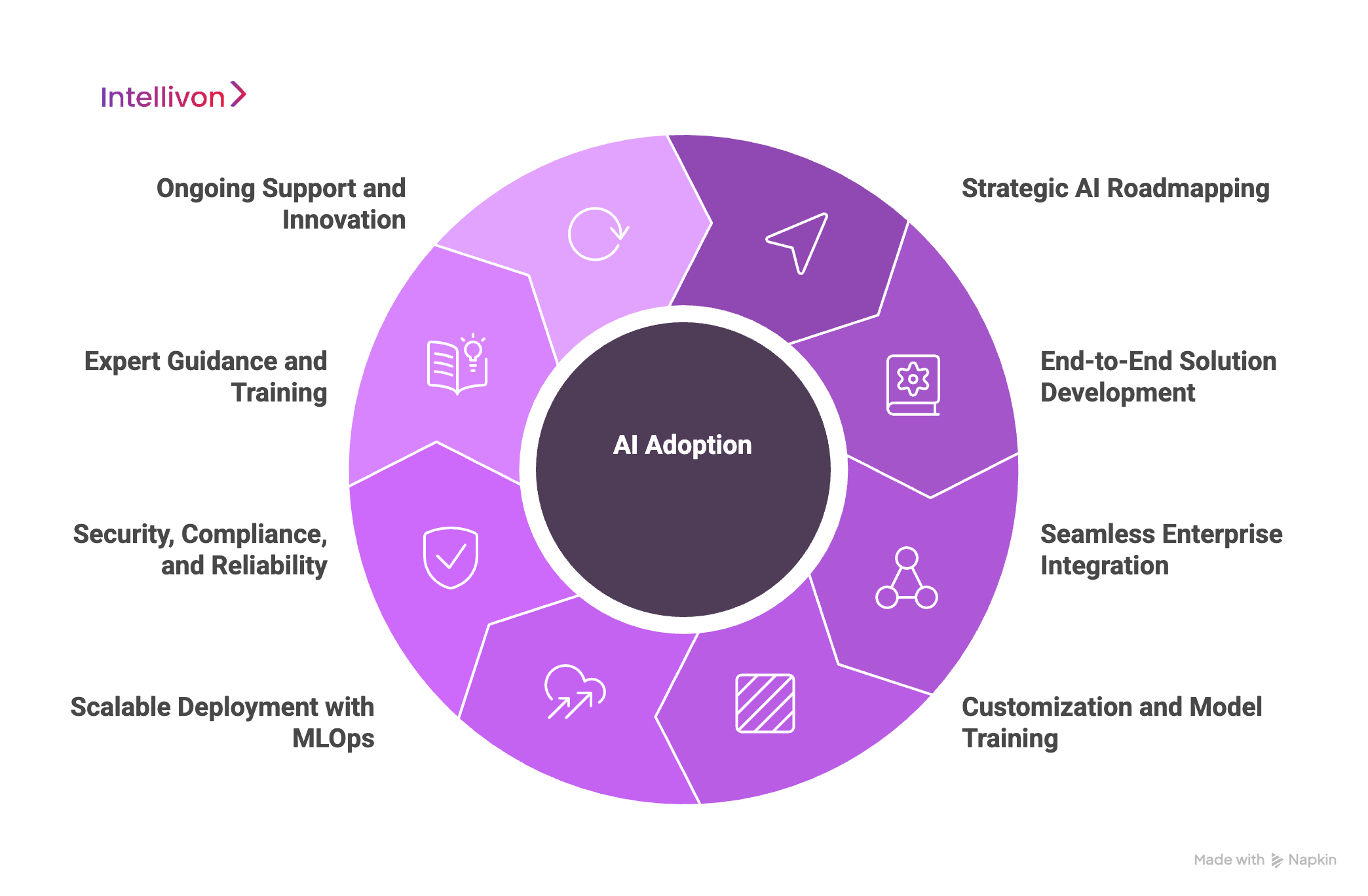
1. Strategic AI Roadmapping
We begin by understanding your business objectives and pain points. Then we identify which AI trends, like governance, sustainability, or automation, offer the greatest opportunities. Together, we build a tailored AI roadmap, sequencing quick wins and long-term initiatives. Pilot projects validate value early, while KPIs (e.g., reducing compliance review time by 80%) ensure business impact.
2. End-to-End Solution Development
Our team designs and builds custom AI solutions across data engineering, ML Ops, and system integration. Whether creating an internal model marketplace or deploying physical AI robots, we emphasize modular, scalable architectures. For example, an AI compliance “checker” can be updated easily when new AI-BOM standards emerge, ensuring solutions grow with your needs.
3. Seamless Enterprise Integration
AI systems only create value when connected to real enterprise data and workflows. We integrate new AI platforms with CRMs, ERPs, IoT devices, or legacy databases, ensuring secure pipelines and smooth user experiences. For example, a quantum-hybrid supply chain optimizer is tied directly to your logistics software so its outputs flow seamlessly into execution.
4. Customization and Model Training
Off-the-shelf AI models rarely fit enterprise needs perfectly. We fine-tune models with your data, build synthetic datasets when information is scarce, and adapt solutions to your processes. For example, we train vision models to detect your specific product defects, or fine-tune an LLM assistant to speak in your company’s voice.
5. Scalable Deployment with MLOps
A successful pilot is just the start. We build robust MLOps pipelines to scale AI enterprise-wide, like containerizing models, automating updates, and monitoring performance. Whether rolling out autonomous labs across global R&D centers or deploying hundreds of warehouse robots, we ensure centralized management, security, and resilience.
6. Security, Compliance, and Reliability
Enterprises operate in regulated environments. We embed compliance logging, access controls, and audit trails into every solution. Fail-safes ensure smooth human-AI collaboration: if an AI prediction fails, tasks are gracefully handed off to human experts. This approach safeguards your operations while meeting industry standards.
7. Expert Guidance and Training
Technology adoption is as much about people as it is about systems. We deliver executive workshops, team training, and SOP updates to embed AI into daily operations. From teaching chemists how to run autonomous lab experiments to guiding executives on AI governance, we ensure your teams are confident and empowered.
8. Ongoing Support and Innovation
AI evolves quickly. Intellivon stays by your side to monitor, retrain, and update solutions as regulations, technologies, and business needs change. From integrating new frontier models to scaling synthetic data pipelines, we future-proof your AI strategy. Our long-term partnership means you can adopt innovations with confidence, without disruption.
By combining strategy, engineering, integration, and ongoing support, Intellivon helps enterprises adopt AI trends securely, at scale, and with measurable ROI. We build custom systems that fit your enterprise like a puzzle piece, driving real business outcomes.
Common Implementation Challenges and How We Overcome Them
Adopting cutting-edge AI isn’t without hurdles. Over the years, we’ve seen consistent patterns in the challenges enterprises face, and we’ve developed proven strategies to overcome them.
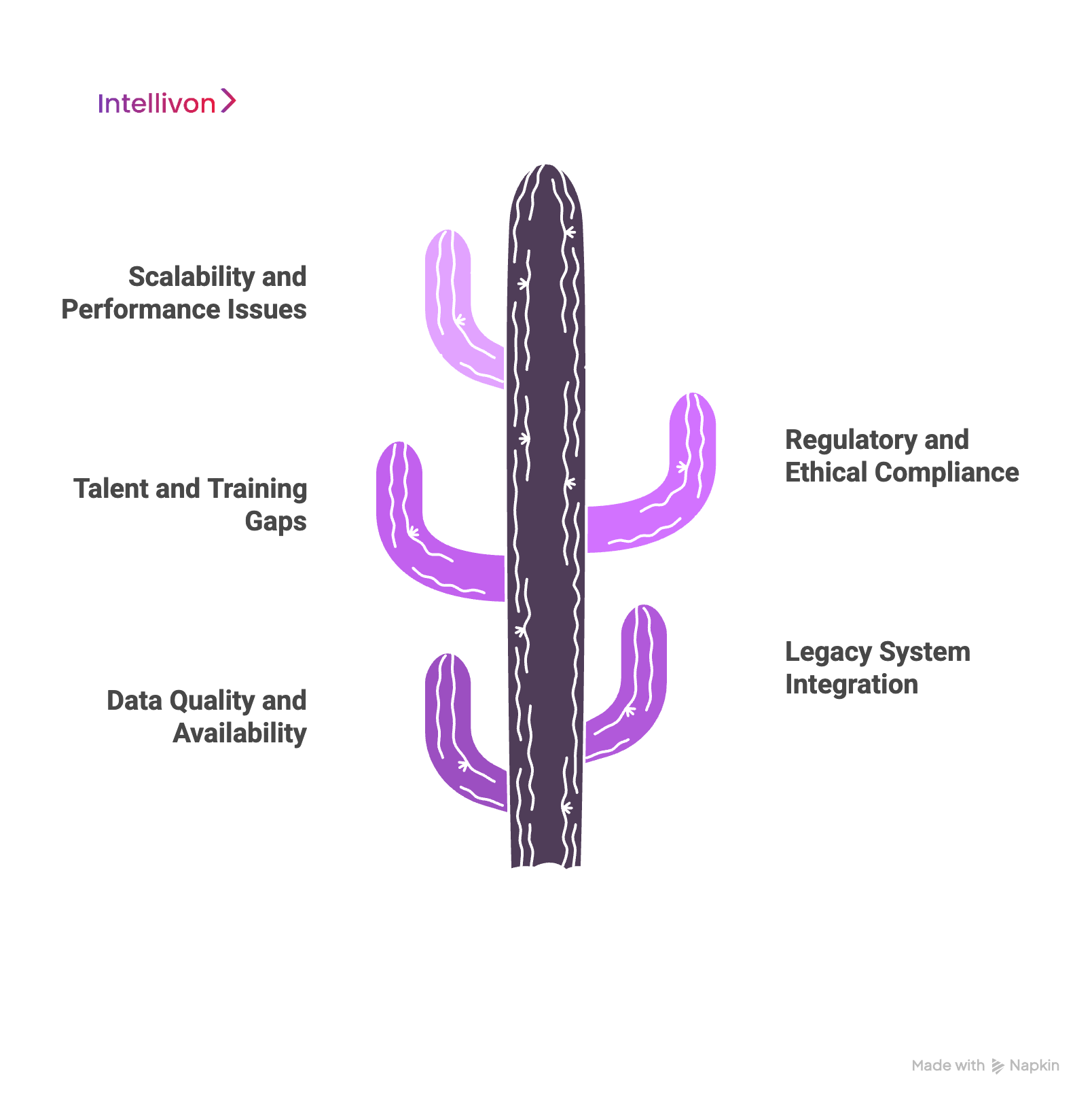
1. Data Quality and Availability
Many enterprises discover their data is siloed, messy, or insufficient to support AI projects. Without the right data, AI cannot deliver meaningful results.
How We Overcome It
Intellivon conducts early data audits to identify sources, assess quality, and integrate silos (e.g., connecting legacy CRMs to modern data lakes). We apply data cleansing techniques to fix inconsistencies and remove noise. When data is limited, we use transfer learning and synthetic data augmentation to fill gaps. For example, if you have 1,000 product defect images, we can generate 50,000 synthetic variations to train a robust vision model. We also implement data governance practices to maintain long-term quality.
2. Legacy System Integration
Enterprises often struggle to connect new AI tools with outdated ERPs, MES systems, or mainframes. Integration complexity slows adoption.
How We Overcome It
Our engineers are skilled in protocols and middleware to bridge gaps (ODBC, SOAP, MQTT, APIs). For instance, we’ve wrapped a 20-year-old mainframe in a lightweight REST API, enabling new AI systems to interact without disrupting existing code. We use shadow deployments to test AI alongside legacy processes, ensuring stability before full rollout. For physical AI, we deploy IoT gateways to translate signals between old equipment and modern AI controllers.
3. Talent and Training Gaps
Enterprises often lack specialists in advanced areas like mixture-of-experts modeling or quantum algorithms. Employees may also fear or resist AI adoption.
How We Overcome It
We combine delivery with knowledge transfer. Our experts mentor internal teams, run custom training sessions, and help set up internal AI guilds for ongoing learning. To ease employee concerns, we host change management workshops that position AI as an assistant, not a replacement. By involving employees in pilot projects, we build ownership and boost adoption.
4. Regulatory and Ethical Compliance
Enterprises worry about staying compliant with strict regulations like GDPR, the EU AI Act, or financial model risk guidelines.
How We Overcome It
We embed compliance into every project. AI-BOMs capture data sources, model lineage, and licensing info to satisfy auditors. We design features like explainability dashboards and bias monitoring filters to ensure fairness. Privacy is addressed through encryption, federated learning, and data residency controls. We also help draft ethical AI guidelines and align solutions with legal requirements to avoid delays or costly rework.
5. Scalability and Performance Issues
A pilot project may work in a lab but collapse at enterprise scale. Latency, throughput, and hardware limitations become bottlenecks.
How We Overcome It
We architect for scale from the start. Using cloud-native services, distributed computing, and autoscaling pipelines, we ensure systems grow with demand. For performance, we optimize models with distillation and quantization to run faster on enterprise hardware. For robotics, we deploy hierarchical control systems to manage fleets without overwhelming central servers. We validate performance through load and stress testing, guaranteeing production-readiness.
Conclusion
The enterprise AI landscape in 2026 will be shaped by unprecedented capabilities, from autonomous labs and quantum accelerators to edge AI chips and collaborative agents. Forward-thinking enterprises are already acting: implementing governance frameworks, deploying robots, and generating synthetic data to fuel innovation.
But success requires more than enthusiasm. It demands strategy, expertise, and flawless execution. Aligning AI with business goals ensures real impact. Enterprises that educate stakeholders, prove ROI, and scale responsibly will lead the future.
Transform Your Enterprise with Intellivon’s Advanced AI Solutions
With over 11 years of expertise in enterprise AI and 500+ successful custom deployments, Intellivon is your trusted partner for building solutions that deliver measurable business impact. From streamlining workflows to generating real-time insights, we help enterprises turn operational challenges into competitive advantages.
Why Choose Intellivon for Your Custom AI Solution?
- Tailored AI Models for Your Industry: We design solutions customized to your workflows, security needs, and strategic objectives.
- Seamless Integration with Enterprise Systems: Our AI integrates effortlessly with ERP, CRM, and legacy platforms for smooth adoption.
- Proven ROI and Scalability: Built for long-term value, our solutions reduce manual effort, accelerate decisions, and scale with your growth.
Want to accelerate digital transformation with secure, scalable, and business-focused AI solutions? Let’s design the right strategy for your enterprise.
Book a discovery call with our AI consultants today and get:
- A full audit of your enterprise AI readiness.
- A tailored roadmap aligned with your strategic goals.
- A detailed implementation plan with projected ROI.
FAQ’s
Q1: Our data is highly sensitive and regulated. Can we still leverage generative AI or cloud-based models securely?
A1. Yes. Enterprises can adopt generative AI securely using sovereign or air-gapped deployments, synthetic data, and encryption. These methods keep sensitive information protected, ensure compliance, and allow organizations in regulated industries to benefit from AI without exposing real customer data.
Q2: How can AI-driven labs work in complex domains like pharma R&D?
A2. AI labs accelerate discovery instead of replacing their scientists. Researchers define rules, safety limits, and objectives, while AI runs rapid experiments. Together, this human-AI partnership uncovers patterns, speeds breakthroughs, and explores vast possibilities that would take humans years to test alone.
Q3: We already have AI models. How do governance and composable AI impact them?
A3. Governance enhances reliability by documenting model lineage, checking compliance, and monitoring bias. Composable AI reuses your existing models as modular building blocks, maximizing ROI while enabling collaboration across departments and creating a more scalable, transparent enterprise AI ecosystem.
Q4: What ROI can enterprises expect from adopting these AI trends?
A4. ROI varies by use case, but most enterprises see measurable results within 12–18 months. Benefits include faster product cycles, reduced errors, cost savings, improved compliance, and scalable innovation, delivering long-term value and competitive advantage across industries and departments.
Q5: How do we begin adopting these AI trends?
A5. Start with an AI opportunity workshop and readiness assessment to align business goals with feasible use cases. Then, launch a pilot project in 8–12 weeks, validate value quickly, and use lessons learned to scale adoption successfully enterprise-wide.

